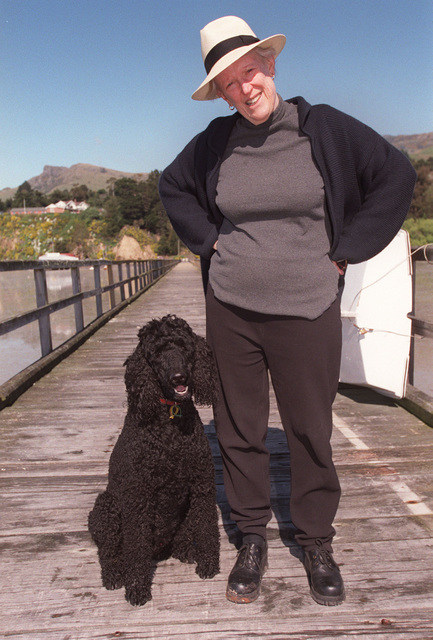Title of the work
Country of the First Edition
Original Language
First Edition Date
First Edition Details
Margaret Mahy, Dangerous Spaces. London: J. M. Dent, 1986, 266 pp.
ISBN
Genre
Magic realist fiction
Mythological fiction
Novels
Target Audience
Young adults
Cover

We are still trying to obtain permission for posting the original cover.
Author of the Entry:
Elizabeth Hale, University of New England, ehale@une.edu.au
Peer-reviewer of the Entry:
Miriam Riverlea, University of New England, mriverlea@gmail.com
Daniel A. Nkemleke, University of Yaounde 1, nkemlekedan@yahoo.com

Portrait of Margaret Mahy with her dog, courtesy of David Alexander.
Margaret Mahy
, 1936 - 2012
(Author)
Margaret Mahy was born in 1936, in Whakatane, in the North Island New Zealand, the daughter of an engineer (a bridge-builder) and a teacher. From her early years, she was a precocious reader and writer. She studied for a BA at the then University of New Zealand, before training as a librarian in Wellington. Her first stories were published in the New Zealand School Journal, and were published internationally from 1969, following their discovery by an American editor. Before she was able to support her full time writing, Mahy drove a book bus in Canterbury, in the South Island, and worked as a librarian at the Christchurch Public Library. She wrote over 100 works, including novels, story collections, picture books, songs, essays and plays, and received many literary awards, both nationally and internationally. She was awarded the New Zealand Prime Minister’s Award for Literary Achievement (2005), and the Hans Christian Andersen Award (2006) and the Sir Julius Vogel Award for Services to New Zealand Science Fiction and Fantasy (2006). She died in 2012. In 2015, the Margaret Mahy Family Playground was opened in central Christchurch.
Sources:
Dossier, Nomination to IBBY Hans Christian Andersen Awards DATE. Country of Nomination: New Zealand; Writer Candidate: Margaret Mahy.
Duder, Tessa, Margaret Mahy: A Writer’s Life, Auckland: Harper Collins, 2012.
Profile at the bookcouncil.org.nz (accessed: June 27, 2018).
Bio prepared by Elizabeth Hale, University of New England, ehale@une.edu.au
Translation
Danish: Fortiden vender tilbage, trans. Ilse M. Haugaard, Copenhagen: Gyldendal, 1986.
Dutch: Listen en lagen, trans. Karin Bron, Amsterdam: Querido, 1988.
French: Les Ensorceleurs, trans. Camille Todd, Paris: Gallimard, 1991.
Japanese: クリスマスの魔術師 [Kurisumasu no majutsushi], trans. Junk Yamada, Tokyo: Iwanami Shoten, 1996.
Swedish: Trixarna, trans. Mats Thorell, Stockholm: AWE/Geber, 1988.
Summary
In Dangerous Spaces, set on the Banks Peninsula near Christchurch, New Zealand, Margaret Mahy explores the myth of Demeter and Persephone through a story about two cousins, Flora and Anthea, who travel by means of a magical stereoscope machine to a mythical realm, called Viridian. Anthea’s parents have died in a sailing accident, and she has come to live with Flora’s family, in the old house her parents are slowly renovating. This house was built by the cousins’ grandfather, Old Lionel. The girls sleep in adjoining rooms and can see one another through a hole in the wall. Flora, who is stocky and freckled, resents Anthea’s pale beauty and tragically interesting story and is afraid that she will supplant her with her mother. Anthea is both resentful of having no privacy and suicidally depressed, wanting only to join her parents. When the girls discover the stereoscope and look through it at a magical landscape, they open a portal to Viridian. There, Anthea meets Griff, a lonely boy, who asks her to stay with him, and promises that she can rejoin her parents. As Anthea becomes increasingly withdrawn, Flora discovers her secret. Joining her in Viridian, she rescues her from Griff, before she is lost forever. Flora finds in her actions the heroism that she has long desired for herself. It emerges that Griff is the brother of Old Lionel, who had died as a boy, and has been waiting in Viridian for his brother, and the brothers are eventually reunited. It emerges too, that the house is haunted by Old Lionel, who resents the renovations the parents are undertaking. Once the brothers are reunited, the house is no longer haunted, and the family can move forward, with Anthea integrated into the fold.
Analysis
Dangerous Spaces maps the underworld rescue-stories of Demeter and Persephone, and Orpheus and Euridice onto this story of two cousins, one suicidal, and the other rescuing her. It represents Mahy’s continued use of classical myth to talk productively about issues of adolescent identity, coming of age, and the family psychodrama: here, Flora overcomes her resentment of Anthea by assuming the role of Demeter, heroically rescuing her cousin, restoring her to the family fold, and shoring up her own sense of herself along the way. Alongside these issues of the dysfunctional family, are issues of heritage and inheritance — the haunted house represents the layers of generations in a young country. Mahy’s characteristic magic realism intertwines myth, magic, the paranormal, and invests them in a family drama set in the mundane outskirts of Christchurch, in an ongoing investigation into depicting the extraordinary in the ordinary which is typical of her approach to writing.
Further Reading
Gavin, Adrienne, “Becoming New Zealand Writers: Margaret Mahy and The Tricksters’ Harry Hamilton”, in The Lion and the Unicorn 39.2 (2015): 166–185.
Hale, Elizabeth and Sarah Fiona Winters, Marvellous Codes: The Fiction of Margaret Mahy, Wellington: Victoria University Press, 2005.
Jackson, Anna, Geoffrey Miles, Harry Ricketts, Tatjana Schaefer, and Kathryn Walls, A Made-Up Place: New Zealand in Young Adult Fiction, Wellington: Victoria University Press, 2011, 224 pp.
Pohl, Michael, Classical Myth and Margaret Mahy's Young Adult Fiction: A Thesis Submitted to the Victoria University of Wellington in Fulfilment of the Requirements for the Degree of Master of Arts in English Literature; Victoria University of Wellington, 2010.
Waller, Alison, "‘Solid All the Way Through’, Margaret Mahy’s Ordinary Witches", Children’s Literature in Education 35.1 (2004): 77–86.
Wilkie-Stibbs, Christine, The Feminine Subject in Children's Literature, New York: Routledge, 2002.
Addenda
Mahy is a New Zeland writer, though many of her books were first published overseas.


